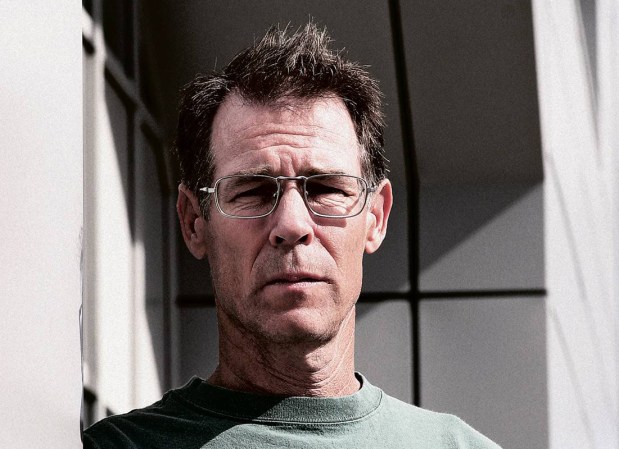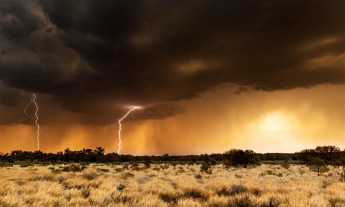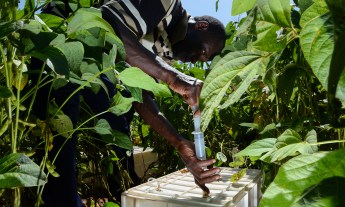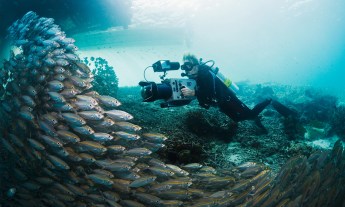
Named a “Hero of the Environment” by Time magazine in 2008, Kim Stanley Robinson writes books that offer a twisted take on how life might be for future generations of humans (and the non-humans we will likely evolve to be). Here, read an excerpt from his novel 2312, which describes Earth of 300 years from now, long after clean tech failed to save us.
When you look at the planet from low orbit, the impact of the Himalayas on Earth’s climate seems obvious. It creates the rain shadow to beat all rain shadows, standing athwart the latitude of the trade winds and squeezing all the rain out of them before they head southwest, thus supplying eight of the Earth’s mightiest rivers, but also parching not only the Gobi to the immediate north, but also everything to the southwest, including Pakistan and Iran, Mesopotamia, Saudi Arabia, even North Africa and southern Europe. The dry belt runs more than halfway across the Eurasia-African landmass — a burnt rock landscape, home to the fiery religions that then spread out and torched the rest of the world. Coincidence?
In North Africa the pattern is now disrupted by many big shallow lakes dotting the Sahara and the Sahel. The water has been pumped out of the Mediterranean and deposited in depressions in the desert, often in ancient lake beds. Some of these are as big as the Great Lakes, though much shallower. They’re freshwater lakes; the water from the Med has been progressively desalinated on its way inland, and the recovered salts have been bonded with fixatives to make excellent white bricks and roof tiles. White roof tiles covered by translucent photovoltaic film have been used for all new construction since the Accelerando, and retrofitted onto many older roofs as well; these days when seen from space, cities look like patches of snow.
But clean tech came too late to save Earth from the catastrophes of the early Anthropocene. It was one of the ironies of their time that they could radically change the surfaces of the other planets, but not Earth. The methods they employed in space were almost all too crude and violent. Only with the utmost caution could they tinker with anything on Earth, because everything there was so tightly balanced and interwoven. Anything done for good somewhere usually caused ill somewhere else.
This caution about terraforming Earth expressed itself in clots and gouts of sometimes military bickering. Political crosschop led to legal gridlock. Big geoengineering projects were all assumed to contain within them an accident like the Little Ice Age of the 2140s, which was generally said to have caused the death of a billion people. Nothing now could overcome that fear.
Also, for many of Earth’s problems, there was simply nothing to be done. The heating and subsequent expansion of the ocean’s water — also its acidification — nothing could be done about these. There was no terraforming technique that would help. Some water had been pumped onto the dry basins of North Africa and central Asia, but the capacity was not there to hold very much of the ocean’s excess volume. Maintaining the one healthy ice cap remaining to them, high on East Antarctica, was a priority that meant no one was comfortable pumping salt water up there to freeze, as had sometimes been proposed, because if something went wrong and they lost the whole ice cap, it would raise sea level another fifty meters and deal humanity something very like a death blow. So caution was in order, and ultimately it had to be admitted: the new sea level could not be substantially altered. And it was much the same with many of their other problems. The many delicate physical, biological, and legal situations were so tightly knitted together that none of the cosmic engineering they were doing elsewhere in the solar system could be fitted to the needs of the place.
Despite this, people tried things. So much more power than ever before was at their command that some felt they could at last begin to overturn the Jevons Paradox, which states that the better human technology gets, the more harm we do with it. That painful paradox has never yet failed to manifest itself in human history, but perhaps now was the tipping point — Archimedes’ lever brought to bear at last — the moment when they could get something out of their growing powers besides redoubled destruction.
But no one could be sure. They still hung suspended between catastrophe and paradise, spinning bluely in space like some terrible telenovela. Scheherazade was Earth’s muse, it seemed; it was just one damn thing after another, always one more cliffhanger, clinging to life and sanity by the skin of one’s teeth; and so the spacers kept on coming home, home to home’s nightmares, with the Gordian knot tied right in their guts.
 Kim Stanley Robinson is a New York Times bestselling author, winner of the Hugo, Nebula, and Locus awards. He is the author of more than 20 books, including the Mars trilogy and titles including Forty Signs of Rain, Sixty Days and Counting, Galileo, and 2312. He works with the Sierra Nevada Research Institute and lives in Davis, California. Author image: SFXFuture Publishing, 2005.
Kim Stanley Robinson is a New York Times bestselling author, winner of the Hugo, Nebula, and Locus awards. He is the author of more than 20 books, including the Mars trilogy and titles including Forty Signs of Rain, Sixty Days and Counting, Galileo, and 2312. He works with the Sierra Nevada Research Institute and lives in Davis, California. Author image: SFXFuture Publishing, 2005.













